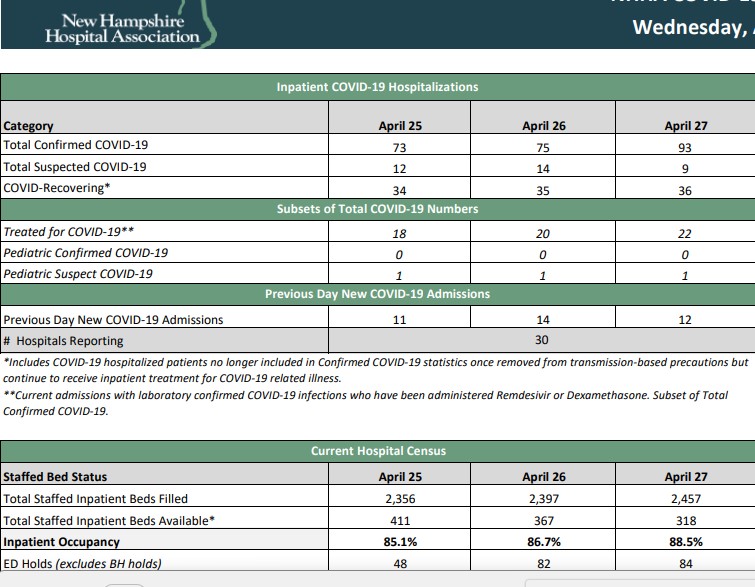By NANCY WEST, InDepthNH.org
CONCORD – The state Department of Health and Human Services continues to lead its daily COVID-19 press releases with the number of total new cases even though Gov. Chris Sununu recently chided reporters for reporting the statistic saying it is vastly underreported because of home testing.
On Wednesday, DHHS’s press release reported 514 new cases, but said that 100 of those were from backlogged cases. On Tuesday, DHHS reported 207 new cases, half of Wednesday’s numbers.
DHHS is also reporting much lower numbers for COVID-19 hospitalizations than the New Hampshire Hospital Association website.
On Wednesday, the state reported 20 COVID-19 hospitalizations. The NHHA website reported 93 total confirmed cases in the state’s hospitals.
It also reported 9 suspected cases, 36 patients recovering from COVID-19, which includes hospitalized patients no longer included in confirmed COVID-19 statistics, and 22 treated specifically with medicine for COVID-19.
DHHS recently switched to counting just those hospitalized patients who are actively being treated for COVID-19 with medications, but that would still be 2 lower than on the NHHA website.
Sununu’s spokesman Ben Vihstadt said the governor has been outspoken about the underestimation on total COVID-19 cases because home tests are not reported to the state. Vihstadt didn’t specifically answer why DHHS continues to send out the news releases with the underestimated case numbers.
Vihstadt said Sununu has addressed the question many times in recent months.
“To reiterate: The case data reported across the country does not account for the massive increase in at-home test usage. As such and given the effectiveness and prevalence of the COVID vaccine, case positivity data alone is not a measurement that any state is using to dictate policy changes,” Vihstadt said in an email.
Steve Ahnen, the president of New Hampshire Hospital Association, said hospitals have been collecting important data points to help identify the impact of COVID-19 on their patients and their communities including the number of hospitalizations, hospital bed availability and availability of resources.
“One of the most important metrics has been the total number of people hospitalized with confirmed COVID-19, used by state leadership, hospitals and public health to monitor severity of illness and the prevalence of COVID-19 in New Hampshire,” Ahnen said in an email.
The total COVID-19 impact on hospitalizations includes all confirmed COVID-19 hospitalized patients, regardless of their reason for being in the hospital, he said.
“All COVID-19 confirmed patients require specialized precautions against transmission of the virus to others,” Ahnen said.
Hospitals also continue to take care of patients who remain hospitalized for COVID-19 treatment even after their infectious period is over, known as ‘COVID-19 Recovering,’” he said.
Ahnen also said some patients in hospitals test positive for COVID-19 but are being treated for other reasons while other patients are admitted to the hospital because they are being specifically treated for COVID-19 symptoms.
Specifically looking at those patients that are being treated for COVID-19 with treatments of Remdesivir or Dexamethasone or both helps identify severity of illness, he said.
Jake Leon, spokesman for DHHS, said the difference in hospitalization data between the state and the New Hampshire Hospital Association has been addressed many times.
“As detailed in the March 29 press release (https://www.covid19.nh.gov/sites/g/files/ehbemt481/files/documents/2022-03/covid-19-update-03292022_0.pdf), the State has transitioned to a new metric, ‘Current Hospitalizations Treated for COVID-19.’
“The state reports out individuals who are in a hospital due to their COVID diagnosis, and not those who are hospitalized for other health care needs (like a broken leg, surgery, etc.), who may incidentally have COVID, but not require any special treatment for COVID.
“In essence, the state’s hospitalization numbers capture those who are in the hospital *because* of their COVID diagnosis, and not someone who could be asymptomatic but in the hospital for a completely different reason,” Leon said.





